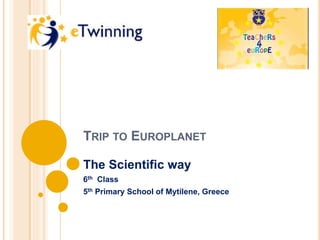Trip to Europlanet the scientific way
- 1. TRIP TO EUROPLANET The Scientific way 6th Class 5th Primary School of Mytilene, Greece
- 2. We are the students of the 6th Class of the Primary Schools of Mytilene. We are ready to travel to Europlanet. We know all about EU travellersŌĆÖ rights, rules and regulations. IŌĆÖm the Captain of the Astro- team. You can call me Captain Nick!
- 3. After studying the laws of Physics and Chemistry carefully, we reached the conclusion that we can launch a spaceship and reach Europlanet in no time! We conducted a science experiment demonstrating how a chemical reaction can launch a rocket, to make sure it will work !
- 4. ŌĆóOne empty 35mm plastic film canister and lid (the type whose lid fits INSIDE the canister, rather than snaps on the outside of the rim). ŌĆóOne fizzing antacid tablet ŌĆóWater ŌĆóSafety goggles
- 5. And a paper-rocket, of course, designed scientifically! Paper, tape, scissors, crayons to make your ŌĆśrocketŌĆÖ !
- 7. 1. Put on the safety goggles . YouŌĆÖd better try this outside because when this works, that film canister really flies! If you want to try the indoor version, do not turn the canister upside down in step 5. 2. Break the antacid tablet in half. 3. Remove the lid from the film canister and put a teaspoon (5 ml) of water into the canister.
- 8. DO THE NEXT 2 STEPS QUICKLY ’éó 4. Drop the tablet half into the canister and snap the cap onto the canister (make sure that it snaps on tightly.) ’éó 5. Quickly put the canister on level ground CAP SIDE DOWN and STEP BACK at least 2 meters. ’éó 6. About 10 seconds later, you will hear a POP! and the film canister will launch into the air! ’éó Caution: If it does not launch, wait at least 30 second before examining the canister. Usually the cap is not on tight enough and the build up of gas leaked out.
- 10. When you add the water it starts to dissolve the tablet. This creates a gas call carbon dioxide. As the carbon dioxide is being released, it creates pressure inside the film canister. The more gas that is made, the more pressure builds up until the cap it blasted down and the rocket is blasted up. This system of thrust is how a real rocket works whether it is in outer space or here in the earth's atmosphere. Of course, real rockets use rocket fuel. You can experiment controlling the rocket's path by adding fins and a nose cone that you can make out of paper.
- 11. Final Countdown ! And off we go!! Rocket launched!
- 12. LETŌĆÖS TALK SCIENCE NOW. How does this simple demonstration show all THREE of NewtonŌĆÖs laws? ’éó NewtonŌĆÖs first law tells us that an object at rest stays at rest, and an object in motion stays in motion, unless something acts on it. This ŌĆ£unbalanced forceŌĆØ causes it to either move or stop moving {or change direction}. The unbalanced forced in this resting rocket is created when the gas builds up inside and pushes the lid of the film canister off. ’éó NewtonŌĆÖs second law tells us that the acceleration of an object is directly related to the magnitude and direction of the force and the mass of the object. In this case, the acceleration of the rocket is proportional to the force and speed of the water and gas being expelled from the canister. ’éó NewtonŌĆÖs third law tells us that for every action {or force} there is an equal and opposite reaction. The force of the canister lid being pushed downward, causes the equal and opposite force of the rocket being pushed upward.
- 13. Food for thoughtŌĆ”.. 1. Does water temperature affect how fast the rocket launches? 2. Does the size of the tablet piece affect how long it takes for the rocket to launch? 3. Can the flight path be controlled by adding fins or a nosecone to the canister? 4. How much water in the canister will give the highest flight? 5. How much water will give the quickest launch?
- 14. BIBLIOGRAPHY ’éó http://www.raisinglifelonglearners.com/2012/10/its- rocket-science.html ’éó http://www.sciencebob.com/experiments/filmrocket. php ’éó ╬”ŽģŽā╬╣╬║╬¼ ╬Ż╬żŌĆÖ ╬ö╬Ę╬╝╬┐Žä╬╣╬║╬┐ŽŹ, ╬ĢŽü╬ĄŽģ╬ĮŽÄ ╬║╬▒╬╣ ╬▒╬Į╬▒╬║╬▒╬╗ŽŹŽĆŽäŽē, ╬Æ╬╣╬▓╬╗╬»╬┐ ╬£╬▒╬Ė╬ĘŽä╬«, ╬Ā╬▒╬╣╬┤╬▒╬│Žē╬│╬╣╬║Žī ╬Ö╬ĮŽāŽä╬╣Žä╬┐ŽŹŽä╬┐














